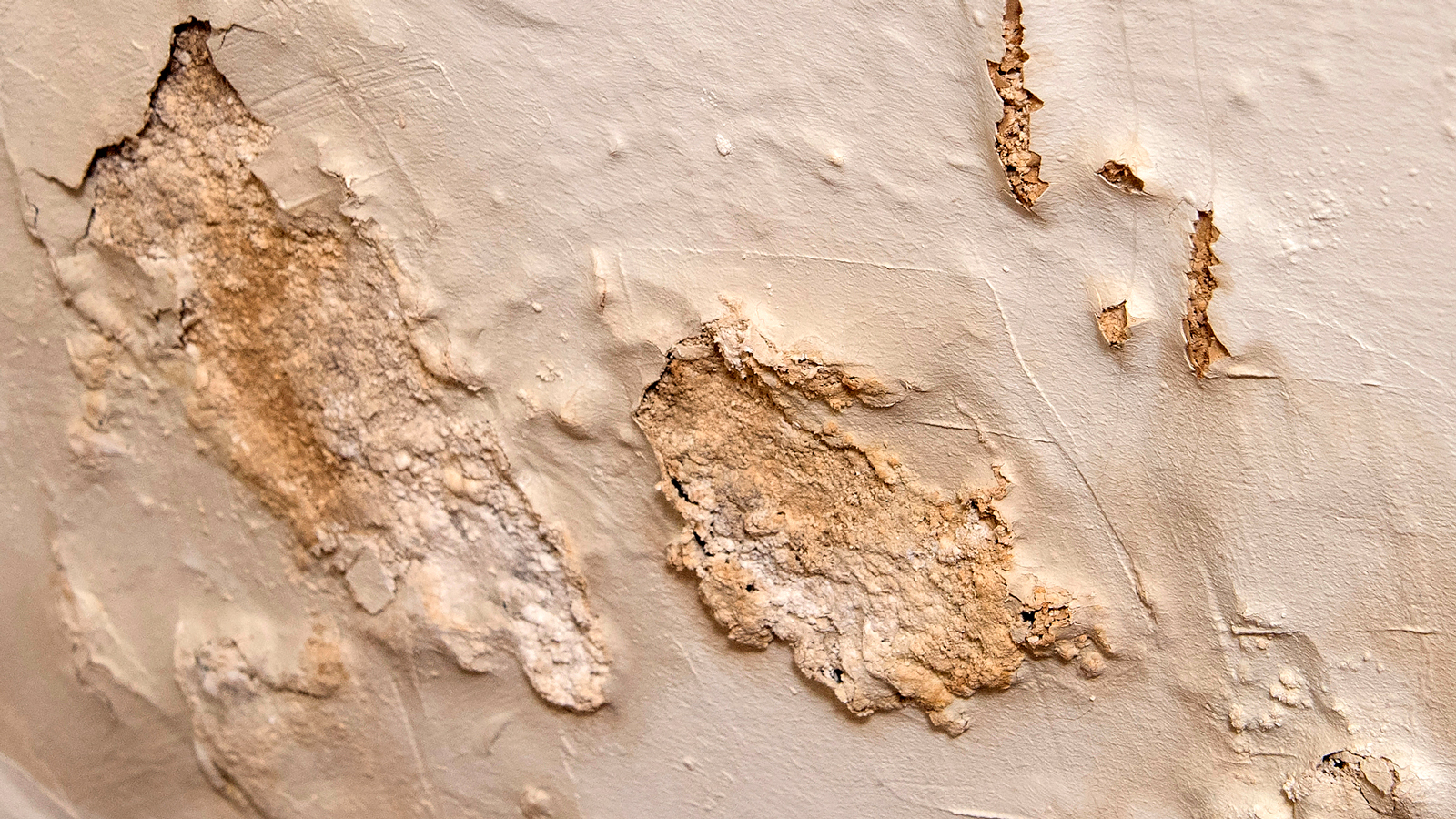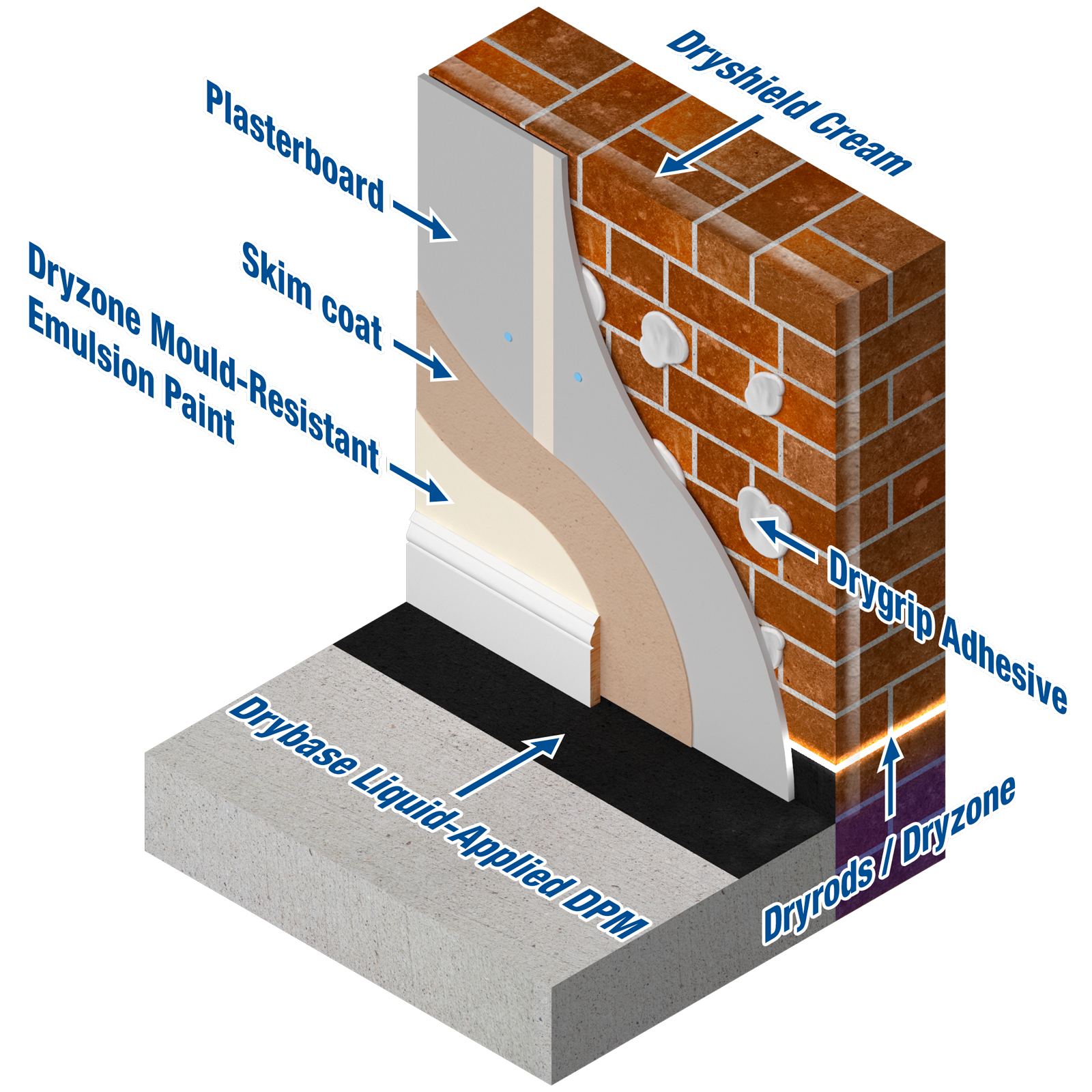Part 4: Replastering Following Insertion of a Damp‐Proof Course
Replastering Salt Contaminated Walls
A: The Need to Replaster
Why Is Replastering Sometimes Necessary?
Dryzone Damp-Proofing Cream and Dryrod Damp-Proofing Rods offer an effective treatment for rising damp in walls of all types. Independent tests demonstrate that once Dryzone Damp-Proofing Cream or Dryrod Damp-Proofing Rods have been inserted into a mortar course they are able to spread and form an effective damp‐proof course – blocking any further rising damp.
However, rising damp treatments are unable to undo any salt and moisture damage caused to plaster prior to treatment. Neither will they remove hygroscopic (moisture attracting) salts from the plaster that have accumulated over the years through the wall which was suffering from rising damp. For this reason, sections of plaster will often have to be replaced as part of an effective rising damp treatment strategy.
Deciding Which Plaster Needs Replacing

Hygroscopic salt contamination - Heavily salt‐contaminated plaster will always need to be replaced – irrespective of which damp‐proofing system is used.
Deciding which sections of plaster need to be replaced requires specialist knowledge and judgement. This is one of the reasons that it is advantageous to employ the services of a specialist damp‐proofing contractor. Highly salt contaminated plaster that is in obvious need of replacement will normally be easy to spot by visual means alone. However moderately salt contaminated plaster that could be storing up future problems is often harder to identify.
In addition to the level of salt contamination other factors may be taken into account when deciding on the extent of replastering to be carried out. These include:
-
The effectiveness of the remedial damp‐proof course.
Dryzone Damp-Proofing Cream and Dryrod Damp-Proofing Rods provide a highly effective damp‐proof course even in saturated walls. This results in salts in the wall being less mobile and therefore less able to migrate further into the plaster. For this reason the use of either Dryzone Damp-Proofing Cream or Dryrod Damp-Proofing Rods allows more original plasterwork to be retained than would if less effective rising damp treatments had been used. -
The existing plaster type.
Is it a gypsum, lime, or cement-based plaster? Some types of plaster (e.g. gypsum) are generally less resilient to salts than other types (e.g. cement). -
Whether the property owner or tenant is willing to wait before replastering.
Where time permits, delaying replastering work for six months or more after the installation of the damp‐proof course is beneficial as it allows a more informed decision to be made as to which sections of plaster need to be replaced.Where the plaster appears to be in sound condition, the extent of plaster to be removed may be minimised by delaying any decision to replaster until the drying period is complete. In such cases the surveyor should offer clear advice on the risks arising of possible damage to decorations in the future.
BS 6576:2005 “Code of practice for diagnosis of rising damp in walls of buildings and installation of chemical damp-proof courses”
-
The type of building affected.
In heritage properties, a desire to keep as much of the original plaster as possible may lead to minimal replastering being carried out. This is done with the understanding that this carries a higher risk of future salt damage to decor and moisture problems related to the continuing presence of hygroscopic salts. In properties intended for rental more widespread replastering might be carried out as the main consideration will be to allow the property to be re‐introduced to the market as soon as possible.
Faster Redecoration
Where it is desirable to redecorate immediately after the insertion of Dryzone / Dryrod (e.g. rented accommodation) consideration should be given to the use of the Dryzone Express Replastering System described later in this guide.
B: Choosing a Replastering System for Walls Affected by Rising Damp
The design function of the new plaster system is twofold:
- It must prevent the passage of residual moisture reaching the decorative surface during the drying process, which can take some considerable time.
- It must prevent the passage of hygroscopic salts from the underlying masonry to the new decorative surface to prevent further spoiling.
In order to perform these functions the replastering has to be carried out strictly in accordance with one of two Safeguard replastering specifications.
Replastering System No.1: Dryzone Express Replastering System

A modern plasterboard-based replastering system that is fully approved by the BBA for use in conjunction with Dryzone Damp-Proofing Cream or Dryrod Damp-Proofing Rods (see Figure 17).
After the removal of existing plaster, the wall is primed using Dryshield Cream (salt inhibitor and primer) before plasterboard is bonded to the wall using Drygrip Adhesive which has been specifically formulated to resist moisture and salts. The system has the advantage of being breathable and allowing redecoration to be carried out immediately – making it an attractive solution for social housing and other rented accommodation.
A further advantage of the Dryzone Express Replastering System is that it can be adapted for use with insulated plasterboard – allowing energy‐saving obligations (e.g. those set out in Building Regulations Approved Document L1B) to be met.
The system is quicker and consequently less expensive to install per m2 than traditional “wet” plaster systems, and allows the use of cement‐based plasters to be avoided when treating rising damp on heritage projects.
Replastering System No.2: Dryzone Damp-Resistant Plaster

The traditional approach to replastering after the installation of a new damp‐proof course is to use a specialist salt and moisture-resistant plaster such as Dryzone Damp-Resistant Plaster. This system has the advantage of being suitable for application onto uneven walls (see Figure 18).
Dryzone Damp-Resistant Plaster benefits from higher water vapour permeability (breathability) compared with sand:cement renders.
